In the realm of workplace safety, few assessments are as critical as the abrasive wheel test. If you’re not already familiar with this test, you might wonder what it involves and why it matters. In this blog post, we’ll break down the abrasive wheel test, its purpose, and the importance of ensuring that those who work with abrasive wheels are properly trained and assessed.

Understanding the Abrasive Wheel Test
The abrasive wheel test, often referred to as the abrasive wheels training, is a mandatory examination for individuals who use or supervise the use of abrasive wheels in the workplace. Abrasive wheels are essential tools in many industries, including construction, metalworking, and manufacturing. They are commonly used for cutting, grinding, and finishing various materials.
This test assesses an individual’s knowledge and competence in working safely with abrasive wheels. It covers various aspects, including the identification and selection of the right abrasive wheel for a specific task, correct mounting and balancing procedures, safety precautions, and understanding the potential risks associated with abrasive wheel use.
Why Is the Abrasive Wheel Test Necessary?
Safety: The primary purpose of the abrasive wheel test is to ensure that workers can operate abrasive wheels safely. These tools can be hazardous if not used correctly, leading to accidents and injuries. Proper training and assessment reduce the risk of incidents and promote a safer work environment.
Compliance: Many countries and regions require employers to provide adequate training and testing for their employees who work with abrasive wheels. Compliance with these regulations is not only a legal requirement but also a moral obligation to protect the well-being of workers.
Efficiency: Adequate training ensures that workers are proficient in using abrasive wheels, resulting in more efficient and productive work processes. It reduces the likelihood of damaged materials, rework, and wasted time.
Cost Savings: Fewer accidents and equipment damage translate to cost savings. The financial impact of accidents can be significant, and these costs can be mitigated by investing in proper training and testing.
What Does the Test Cover?
The content of the abrasive wheel test typically includes the following:
Identifying types of abrasive wheels: Recognizing the various types and understanding their specific applications is a fundamental part of the test.
Wheel selection: Knowing how to select the appropriate abrasive wheel for a particular task is crucial for safety and efficiency.
Handling and storage: Understanding how to handle, store, and transport abrasive wheels safely.
Mounting and balancing: Properly mounting the wheel on the machine, balancing it, and conducting pre-use checks.
Safety precautions: Awareness of the safety measures and personal protective equipment (PPE) required when working with abrasive wheels.
Hazard identification: Recognizing potential risks and how to mitigate them.
Safe working practices: Implementing safe working practices and knowing what to do in case of accidents or incidents.
In Conclusion
The abrasive wheel test plays a vital role in promoting safety in workplaces where abrasive wheels are used. It ensures that workers have the knowledge and skills to operate these tools safely and efficiently. Employers should prioritize the training and testing of their employees to create a safer, more productive work environment while complying with legal requirements and reducing the risk of accidents and costly incidents.
Online Message
Minimum Order Quantity: 5,000 Pcs, 10 Pcs Free Samples.
Contact Us For More Information!
Tel/WhatsApp
+86 18796960868
DomeGrinding@hotmail.com
Address



